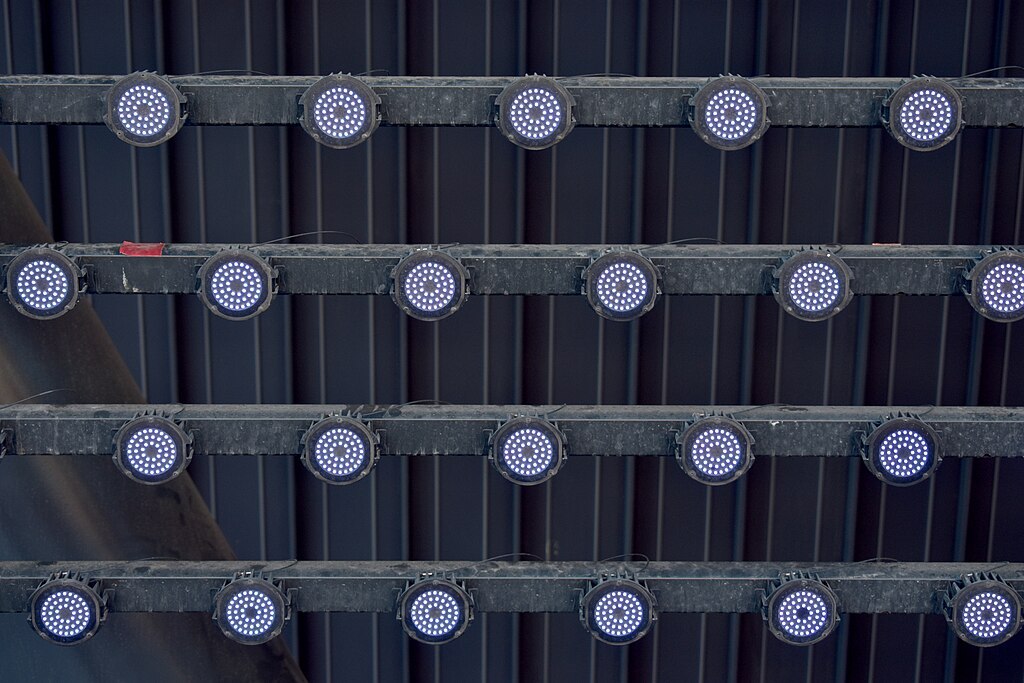
The Las Vegas Sphere is a technological feat, boasting the world's largest interior and exterior screens. (Photo by Y2kcrazyjoker4 is licensed under CC BY 4.0)
With a $2.3 billion construction cost, the Las Vegas Sphere is home to the world's largest and highest-resolution screens, inside and outside. Tourists and residents alike can watch the spherical structure illuminate with crystal-clear, sharp images during the nighttime. Not only that, but the interior display is also jaw-dropping, showcasing its advanced technological capabilities.
The exosphere is 3.5x larger than its interior screen. It has 1.2 million hockey puck-sized lights that have a group of 48 individual LEDs. Every group isn't near each other. That design makes the image as sharp as it appears from a distance rather than blurred when viewers are close to it.

The exterior screen is made of 1.2 million lights with 48 LEDs. (Photo by Y2kcrazyjoker4 is licensed under CC BY 4.0)
The sphere's interior houses an Atrium with the Hypervsn Wall. This wall may appear to have a 3D visual, but that's an illusion. It has hundreds of tiny rotors with LEDs and blades rotating at 670 RPM --- too fast for humans to perceive. This makes it possible to produce many visuals. The Atrium also comes with five Aura humanoid robots for a visitor to speak with, but only their upper bodies move while providing information about the Sphere's tech. Aura runs on all kinds of software, which includes LLMs, such as chatGPT, facial recognition software like MediaPipe, and voice recognition software like Whisper.
The primary screen of the Sphere is inside the theatre and surrounds the audience. This screen --- 256 million pixels --- also consists of extremely thin tiles with LEDs that conform to the Sphere's curvature. Due to its massive surface size, 16,000 sq ft., the screen is only 3.3 ppi. Even then, it still produces a sharp, clear image from where the audience sits because of the optimal viewing distance.
7thsense deployed its cutting-edge media serving and pixel processing technology with LED displays. Both the interior and exterior screens use the same signals, but the interior one is better with higher res, leading to higher-quality visuals. A Network Attached Storage (NAS) system delivers the video signal to the 7thSense Actor media servers (utilizing R-Series 10 hardware and Actor media server software) in uncompressed media.
Those media servers then modify the images to match the curved surface, ensuring they display properly via geometric adjustments. Uncompressed video streams are delivered to Juggler pixel processors that receive video streams from cameras, production trucks, and other sources. Then, the Juggler pixel processors scale, window, and layer video inputs into a pixel canvas before distributing them to the LED panels. Overall, the system synchronizes to a Precision Time Protocol clock for precision.
The audio technology called Sphere Immersive Sound is also the world's best. Developed by HOLOPLOT, the sound system has 1,600 permanent and 300 mobile HOLOPLOT X1 Matrix Array loudspeaker modules and 167,000 loudspeaker drivers hidden behind the screen. This audio system uses 3D Audio Beamforming and Wavefield Synthesis technology to deliver high-quality sound waves to each seat, providing custom audio to different areas of the theater. This is achieved without audio transmission losses thanks to the algorithms in the optimization engine --- delivering clear sound.
Additionally, 10,000 seats are equipped with Powershell's infrasound system that uses transducers to generate haptic feedback. A low-frequency audio signal triggers the haptic feedback technology, causing the chairs to vibrate in response to audio via Quattrocanali amplifiers by Powersoft.
Have a story tip? Message me at: http://twitter.com/Cabe_Atwell
